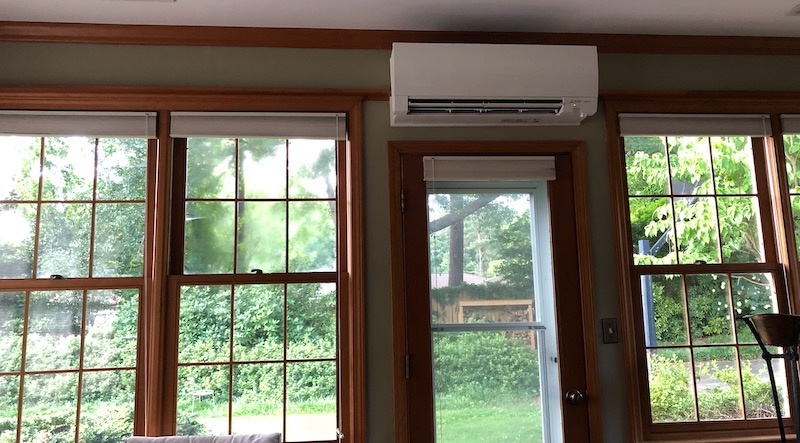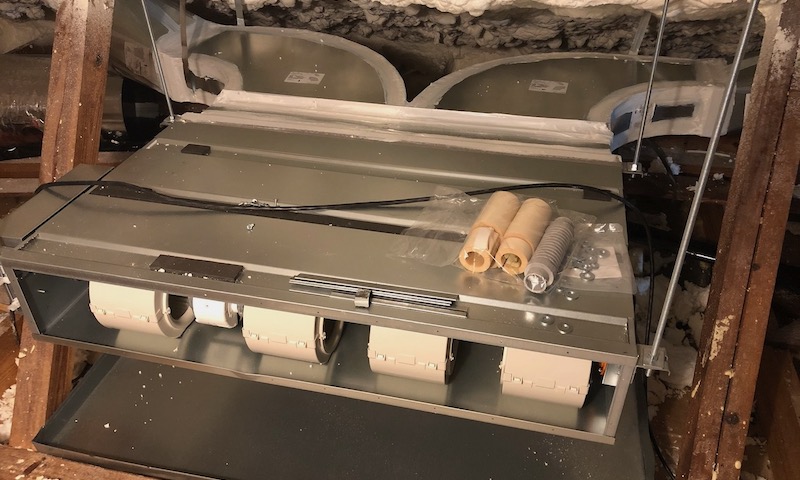
Ah, minisplits. They’re all the rage in the world of high-performance HVAC. But what exactly is a minisplit heat pump? Unfortunately, the terminology around this technology is confusing because it’s used so inconsistently. Let’s start at the beginning. (Well, OK, not all the way at the beginning. I’m not going to explain what a heat pump is, but here’s a primer on how they work for heating.)
The basic meaning
The term “minisplit” itself originally referred to a split-system heat pump (could also be an air conditioner) with a smaller capacity than conventional systems. In that sense, a minisplit is just what its name says it is: a small split-system heat pump. Where it gets confusing is in the different ways manufacturers make these lower-capacity, split-system heat pumps.
A minisplit, for example, can have a conventional fixed-capacity compressor or an inverter-driven variable-capacity compressor. So, a minisplit could be a conventional heat pump that’s just smaller. Or, it could be a smaller heat pump with variable capacity. The former type is rare, though, so when you hear the term “minisplit,” you should think of the type with the inverter-driven compressor with variable capacity.
But it gets worse. This type of heating and cooling system has outgrown its name . . . at least the “mini” part. Yes, you can still get them down to a half ton of capacity (6000 BTU per hour), with smaller capacities on the way. But you can also get minisplits that have a capacity of 4 tons (48,000 BTU per hour), which is far from “mini.”
Is it a minisplit or a multisplit?
Another confusing area is that with this type of heat pump, the outdoor unit can be connected to one indoor unit (referred to as one-to-one), or it could be connected to multiple indoor units. Some people distinguish these two types by using the term “minisplit” only for the one-to-one configuration. When you have more than one indoor unit on a single outdoor unit, that’s a multisplit heat pump, they say.

If we go with that dividing line, I have both a minisplit and a multisplit in my house. The main part of the house is heated and cooled with one outdoor unit connected to two indoor ducted air handlers. That would make it a multisplit. And I use a one-to-one ductless system for my sunroom (above).
Are all minisplits ductless?
And then there’s the issue of the type of indoor unit. Some are ductless, and they come in different flavors: wall-mounted, ceiling cassettes, and floor-mounted. Others are ducted, and they come in horizontal ducted or multi-position types. Some people use the term “minisplit” only for ductless indoor units. Others refer to any type of split system with smaller capacity as a minisplit, no matter whether the indoor unit is ducted or ductless.

I use the term “minisplit” for all of the above. Since minisplits with fixed-capacity compressors are rare, you don’t really need to worry about that confusion. If you’re talking to someone about minisplits, you should be able to tell from the context how they use the term. If not, ask them to clarify.
Inverter-driven minisplit heat pumps
Inverter-driven minisplit heat pumps are the future for high-performance homes. I’ve got them in my home, and it’s what we specify in a majority of our HVAC design jobs at Energy Vanguard. Their high efficiency and variable capacity that can ramp down to very low values are perfect for superinsulated, airtight homes. And they work well in less efficient homes, too.
They give you a couple of other benefits as well. Their lower capacity means you can zone your heating and cooling with separate pieces of equipment. And using separate pieces of equipment provides resilience. If one heat pump stops working, you can still heat or cool the parts of the house that have operable equipment.
One final point here concerns the one-to-one configuration. If you want the highest efficiency, the best zone-to-zone control, and the most resilience, use only one indoor unit on each outdoor unit. Multisplit systems can work fine, but they’re just not as good as one-to-one setups.
Weekly Newsletter
Get building science and energy efficiency advice, plus special offers, in your inbox.















0 Comments
Log in or create an account to post a comment.
Sign up Log in